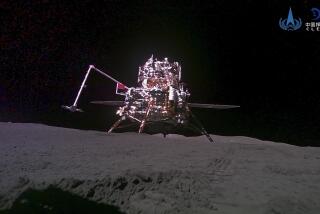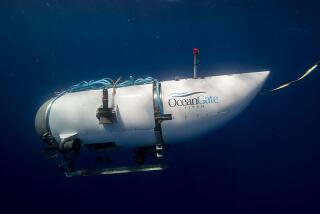Huygens Probe Takes Plunge
- Share via
The Frisbee-shaped Huygens probe successfully separated from the Cassini spacecraft Friday and began a risky 2.5-million-mile journey to the surface of Saturn’s bizarre, smog-choked moon Titan.
Applause burst out at the Jet Propulsion Laboratory shortly after 7:24 p.m., when scientists received word from NASA’s Deep Space Network tracking stations in Spain and Goldstone, Calif., that the Huygens probe had cast off after a seven-year piggyback ride on the Cassini spacecraft. All systems were said to have performed flawlessly in the separation.
“Today’s release was another successful milestone in the Cassini-Huygens odyssey,” said David Southwood of the European Space Agency, which built the Huygens probe. “Now all of our hopes and expectations are focused on getting the first [close-up] data from a new world we’ve been dreaming of exploring for decades.”
That data won’t come for another three weeks, during which time the 9-foot-diameter Huygens probe will chase down Titan and then, if everything goes as planned, hurl itself through the thick, nitrogen-methane atmosphere before crashing into a surface that could consist of anything from a sticky chemical sludge to poison oceans.
Titan has beguiled scientists for years because it is unlike any other place in the solar system. The only moon with an atmosphere, Titan is also of interest because it is thought to resemble the early Earth, before plant life formed and began pumping oxygen into the atmosphere.
Too frigid at minus 290 degrees Fahrenheit to grow life itself, Titan is a kind of frozen museum piece of what an early, Earth-like planet might look like.
The $3.2-billion Cassini mission is a cooperative venture involving NASA, the European Space Agency and the Italian Space Agency. The largest and most ambitious interplanetary probe ever launched, the 6-ton spacecraft lifted off Oct. 15, 1997. The mission involved 260 scientists from 17 nations.
Cassini reached Saturn in July, the first part of a two-part scientific exploration. Cassini first used its array of imaging devices to take detailed pictures as it flew through the planet’s spectacular rings and swung past chilled and broken moons.
In late October, Cassini passed within 745 miles of the surface of Titan. Though the spacecraft’s cameras were able to penetrate the haze in places, the images beamed back to Earth only whetted scientists’ appetites for the second part of the mission, Huygens’ dramatic plunge.
“Have we seen some craters? Perhaps. Some kind of flow on the surface? Perhaps. Vulcanism? Perhaps,” said Jean-Pierre Lebreton, the Huygens project manager for the European Space Agency.
Answering those questions is the job of Huygens, a 700-pound collection of scientific instruments designed to sniff and measure the atmosphere of Titan as it streaks to the surface. Although they are intrigued by images Cassini took in October of what looks to be an irregular land mass dubbed Xanadu, scientists said Friday that they had no fixed idea where the probe would land. Titan’s strong winds could blow it hundreds of miles across the surface.
Scientists are hoping the probe survives its landing long enough to send back information about the surface of the moon.
*
(BEGIN TEXT OF INFOBOX)
Headed toward Titan
The Cassini spacecraft jettisoned its Huygens probe Friday, initiating the probe’s three-week freefall toward the atmosphere of Saturn’s largest moon, Titan. On Jan. 14, Huygens will activate its scientific instruments as it floats to an uncertain rendezvous with Titan’s surface.
Detaching the probe
* Small explosions break the bolts joining the probe to Cassini.
* Springs push Huygens away at about 1 foot a second.
* Probe rotates seven times a minute to stabilize it.
**
The descent
* Instruments shut down for journey from Earth should “wake” on Jan. 14.
* In Titan’s atmosphere, probe’s aeroshield causes dramatic slowing.
* Parachutes deploy, slowing probe further.
* Aeroshell is ejected and instruments activate.
* Radio begins transmitting data to Cassini, which relays it to Earth.
* Descent through atmosphere will last about two and a half hours.
* Probe hits surface at landing spot called Xanadu. It’s not known whether the site is solid or water, making for a potentially dicey landing.
**
The mission
Six instruments on Huygens will:
* Examine weather and chemical composition of Titan’s atmosphere.
* Study physical properties at the probe’s landing site.
* Record sounds and take images of the moon.
**
About Titan
The only moon in the solar system known to have an atmosphere.
Like Earth, Titan is rich in nitrogen and harbors organic molecules and methane gas. The temperature of minus 292 degrees Fahrenheit makes finding signs of life unlikely.
Source: NASA






